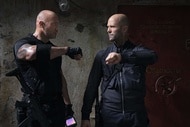Create a free profile to get unlimited access to exclusive videos, sweepstakes, and more!
Did You Know? I, Robot Didn’t Actually Start Off as an Isaac Asimov Adaptation
Screenwriter Jeff Vintar shares how his 1990s sci-fi script transformed into a Will Smith blockbuster.

When I, Robot (streaming at Peacock) finally arrived after a lengthy development in 2004, it came with all the provenance of immutable blockbuster law — the director of The Crow and Dark City, the bankable star power of Will Smith, and a plausible near-future premise lifted straight from the pages of science fiction founding father Isaac Asimov.
But much like the Alex Proyas-directed film’s plot-twisting spin on Asimov’s own Three Laws of Robotics, at least one of those ingredients isn’t quite as simple as it seems on the surface. Though the movie’s title and portions of its lore-verse indeed took inspiration from Asimov’s venerable Robot series of stories (compiled in 1950 under the I, Robot anthology moniker), the original idea that ultimately led 20th Century Fox to bite on the project was hatched by screenwriter Jeff Vintar (The Hot Zone, Final Fantasy: The Spirits Within).
RELATED: ‘I, Robot’ screenwriters talk unmade sequels and why the future is ‘impossible to imagine’
In the mid-1990s, Vintar had written Hardwired, a speculative script whose baked-in story beats — including I, Robot’s overall concept as well as the character of detective Del Spooner (played by Smith in the movie) — shared plenty of affinity with Asimov’s earlier “positronic” robot stories, while building its own sci-fi world around an Agatha Christie-style murder mystery.
Speaking recently with SYFY WIRE, Vintar shared a trove of insight into the fascinating threaded history of how the film, as well as Asimov’s own “hard” sci-fi concepts, evolved through a rich exchange of creative ideas across time — and, after years spent in development hell, eventually culminated in the early-2000s blockbuster movie.
The Origins of I, Robot
“I couldn't blame Fox or anyone for seeing that Hardwired would have made an excellent I, Robot film — because [of] the Asimov stories,” said Vintar. “Asimov loved Agatha Christie, and his Robot stories are Agatha Christie puzzles. That's what the Three Laws are all about ... So the Three Laws themselves were not his idea. They were the idea of [sci-fi writer and Astounding Science Fiction editor] John W. Campbell, who thought that the stories needed something too — thought they needed the Three Laws, and they also needed something to combine them.”
Conceived as a way to assure that androids’ relations with humans would forever remain benign, the Three Laws were one of the few overt Asimov story callbacks that found their way into the final film, cementing its lore connections to Asimov’s I, Robot lore-verse. The other was the character of Dr. Susan Calvin (played by Bridget Moynahan in the movie as a younger, mid-30s version of the octogenarian robo-psychologist from Asimov’s Robot cycle), a reimagined version of the female lead who, in Vintar’s Hardwired script, was reportedly a character named Flynn.
Even the film’s name reaches deeper into the sci-fi written genre’s past than Asimov’s original work, as Vintar pointed out. “It came from a short story by Otto Binder, called I, Robot, which is quite a good story!” he explained. “It was in Amazing Stories in 1939 — 1939 was really the birth of the ‘golden age’ of science fiction.”
As an overall movie adaptation, though, the substance of I, Robot’s plot beats came not from Asimov, but from Vintar’s Hardwired script. There were, of course, some significant page-to-screen changes as the story expanded along the way — a product of “opening it up into a big-budget studio film, because the original script was kind of like a stage play,” as Vintar explained.
The film’s demolition scene, trapping Smith’s character inside a house as a giant smash-‘bot wails away at its foundations, was a later eye-grabbing addition, as was VIKI, the movie’s omnipresent A.I., reimagined from a smiley-faced brainiac ‘bot named “Hector” in Hardwired at the studio’s behest — a change that “still breaks my heart,” Vintar confessed.
But Smith’s Del Spooner character (along with his metal arm), as well as Sonny — the exceptional NS5 prototype robot voiced by Resident Alien star Alan Tudyk — were both key players who were present from the start in Vintar’s original story. The basic setup survived the page-to-screen process, too, including the death of Dr. Alfred Lanning (James Cromwell) and the holographic breadcrumb trail of clues he leaves for Spooner to find once he's gone.
With a screenwriting co-credit also going to Star Trek: Picard and Strange New Worlds co-creator Akiva Goldsman, I, Robot would go on to amass more than $353 million globally, a box office feat that all but tripled the film’s original $120 million production budget. Revisit the film’s Asimov-suffused story with fresh eyes at Peacock, where I, Robot is now streaming around the clock.
Originally published Feb 21, 2023.


























